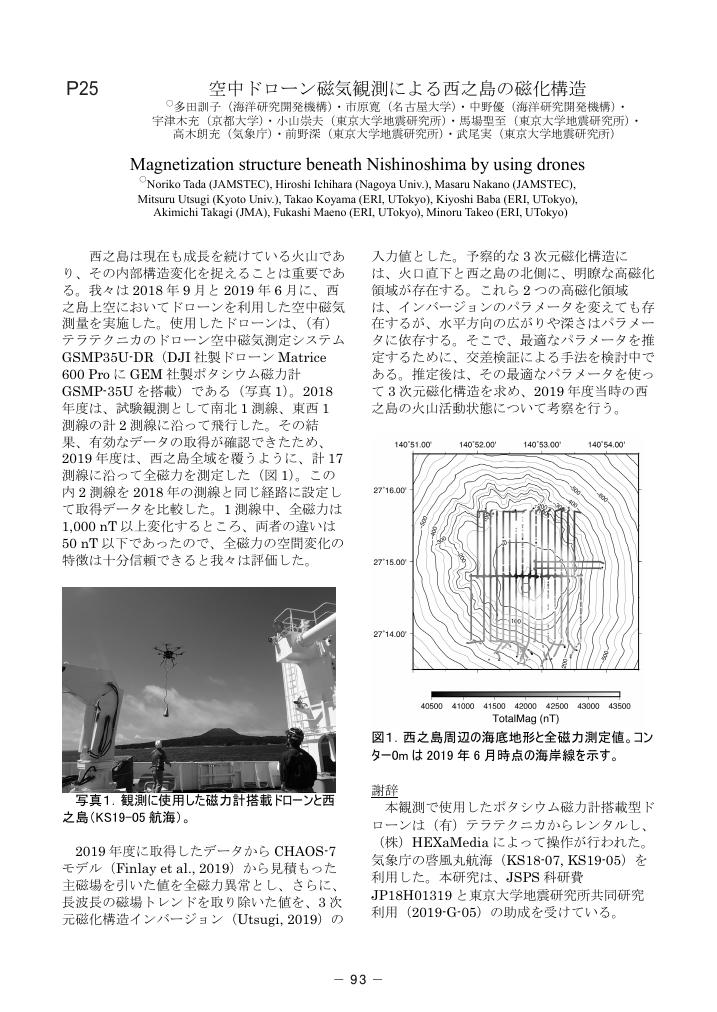3 0 0 0 OA 西之島の地球物理観測と上陸調査
- 著者
- 武尾 実 大湊 隆雄 前野 深 篠原 雅尚 馬場 聖至 渡邉 篤志 市原 美恵 西田 究 金子 隆之 安田 敦 杉岡 裕子 浜野 洋三 多田 訓子 中野 俊 吉本 充宏 高木 朗充 長岡 優
- 出版者
- 海洋理工学会
- 雑誌
- 海洋理工学会誌 (ISSN:13412752)
- 巻号頁・発行日
- vol.24, no.1, pp.45-56, 2018 (Released:2018-08-30)
- 参考文献数
- 12
Nishinoshima is an andesitic stratovolcano located in Ogasawara Islands, Japan. In November 2013, island-forming eruption started. Before the eruption, Nishinoshima was a small island of the area of 0.29 km2 and elevation of 25 m but it had a huge edifice rising 3,000 m from the sea floor. By March 2016, area and elevation reached 2.7 km2 and 140 m, respectively. We conducted various types of geophysical observations at this “difficult-to-access island” (950 km from Tokyo taking 90 min by Jet plane, or 24 h by ship). In June 2016, we conducted airborne observations using unmanned helicopter, collecting 250 grams of scoria and detailed 4K images of lava flows. OBSs (Ocean Bottom Seismometers) were deployed around Nishinoshima in four periods. From February 2015 to May 2017, characteristic waveforms dominated at 4–8 Hz band were frequently observed. Comparisons with infrasonic records and video images revealed that the 4–8 Hz seismic signals were associated with eruptions at pyroclastic cone. The number of seismic signals of this type declined from July 2015, and disappeared in November 2015, suggesting that the eruptive activity started declining in July 2015 and ceased in the middle of November 2015. In October 2016, we landed and deployed a broadband seismometer and an infrasonic sensor in the old Nishinoshima, collecting a lot of new lava, deposits, and ash samples. We demonstrated a capacity of remote-island volcano monitoring system for one day test navigation circling around Nishinoshima. After one and a half year quiescence, a new eruptive phase started in April, 2017. Our on-land seismic sensor detected precursory signals as early as April 17. The seismometer also recorded characteristic waveforms during the very early stage of the new eruption phase before data transmission was terminated on April 21.
1 0 0 0 OA 空中ドローン磁気観測による西之島の磁化構造
- 著者
- 多田 訓子 市原 寛 中野 優 宇津木 充 小山 崇夫 馬場 聖至 高木 朗充 前野 深 武尾 実
- 出版者
- 特定非営利活動法人 日本火山学会
- 雑誌
- 日本火山学会講演予稿集 2020 (ISSN:24335320)
- 巻号頁・発行日
- pp.93, 2020 (Released:2021-02-01)
